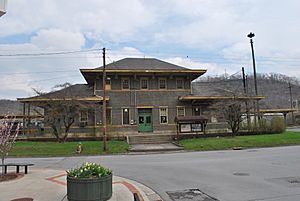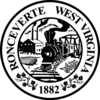Ronceverte, West Virginia facts for kids
Quick facts for kids
Ronceverte, West Virginia
|
||
|---|---|---|

Ronceverte Depot, April 2009
|
||
|
||
| Nickname(s):
The Friendly River City
|
||

Location of Ronceverte in Greenbrier County, West Virginia.
|
||
| Country | United States | |
| State | West Virginia | |
| County | Greenbrier | |
| Incorporated | 1882 | |
| Area | ||
| • Total | 1.73 sq mi (4.48 km2) | |
| • Land | 1.70 sq mi (4.41 km2) | |
| • Water | 0.02 sq mi (0.06 km2) | |
| Elevation | 1,723 ft (525 m) | |
| Population
(2020)
|
||
| • Total | 1,572 | |
| • Estimate
(2021)
|
1,559 | |
| • Density | 980.05/sq mi (378.46/km2) | |
| Time zone | UTC-5 (Eastern (EST)) | |
| • Summer (DST) | UTC-4 (EDT) | |
| ZIP code |
24970
|
|
| Area code(s) | 304 | |
| FIPS code | 54-70156 | |
| GNIS feature ID | 2390647 | |
Ronceverte is a city located in Greenbrier County, West Virginia, United States. It sits right on the Greenbrier River. In 2020, about 1,572 people lived there.
Contents
History and Culture of Ronceverte
Ronceverte got its name from Cecil Clay, who was the president of a big lumber company. He saw the name "Ronceverte" on an old map made by Jesuit explorers. He thought the name sounded nice and looked good when written. Even though some people wanted to name the town "Edgar" because many people with that name lived there, Clay insisted on Ronceverte. The town has been officially called Ronceverte since April 1, 1882.
What Does Ronceverte Mean?
The name Ronceverte comes from the French words for "Bramble Green." This is like the word "Greenbrier," which is a common vine found in the area. A funny story says that early mapmakers got stuck in a thick patch of these thorny vines when they found the Greenbrier River. French mapmakers were probably the first to draw maps of this area, but many details from that time are now lost.
The Greenbrier River's Importance
The Greenbrier River is a very important part of Ronceverte's history and culture. It was one of the first major river ports in the Greenbrier River area. The town has faced big floods from the river in 1985, 1996, and 2016.
Historic Places in Ronceverte
Two important places in Ronceverte are listed on the National Register of Historic Places. The Hokes Mill Covered Bridge was added in 1981. Later, the Ronceverte Historic District was added in 2005.
Ronceverte's Railroad History
Ronceverte is known as a "railroad town." It was an important stop on the C&O lines. These tracks connected Pocahontas County to Hinton and then to Clifton Forge, Virginia. Ronceverte was part of a special train route called the "Gravel Girtie" line. Trains from Hinton would go to a limestone quarry in Fort Spring. There, they would load up with crushed lime. This lime was then sent to Clifton Forge to be used in large furnaces.
During World War II, these train tracks were used to transport German prisoners of war. They were taken to work on local farms and other projects. One of the old train stations, called the Rockland Depot, is no longer there. Only the name Rockland Road in Ronceverte reminds people of it today.
Geography of Ronceverte
Ronceverte covers a total area of about 1.73 square miles (4.48 square kilometers). Most of this area, about 1.70 square miles (4.41 square kilometers), is land. A small part, about 0.03 square miles (0.06 square kilometers), is water.
People and Life in Ronceverte
| Historical population | |||
|---|---|---|---|
| Census | Pop. | %± | |
| 1880 | 395 | — | |
| 1890 | 481 | 21.8% | |
| 1900 | 968 | 101.2% | |
| 1910 | 2,157 | 122.8% | |
| 1920 | 2,319 | 7.5% | |
| 1930 | 2,254 | −2.8% | |
| 1940 | 2,265 | 0.5% | |
| 1950 | 2,301 | 1.6% | |
| 1960 | 1,882 | −18.2% | |
| 1970 | 1,981 | 5.3% | |
| 1980 | 2,312 | 16.7% | |
| 1990 | 1,754 | −24.1% | |
| 2000 | 1,557 | −11.2% | |
| 2010 | 1,765 | 13.4% | |
| 2020 | 1,572 | −10.9% | |
| 2021 (est.) | 1,559 | −11.7% | |
| U.S. Decennial Census | |||
Ronceverte's main business area is downtown. It has railroad tracks running through it and is near a floodplain. This means the town sometimes has to deal with floods.
Community and Recreation
Thanks to grants from people like Tony Hawk and groups like the Izaak Walton League, Ronceverte has improved its public areas. These improvements help people stay healthy and have fun. There's a ball field, a swimming pool, and a playground. You can also find a walking track and a special path to learn about nature. All these areas are next to a public spot on the Greenbrier River. Here, families can have picnics.
The county's recycling center is also nearby. This brings more people and businesses to the area. The public access point on the river has a boat launch for swimming and fishing. There's also an outdoor amphitheater for shows.
Ronceverte River Festival
Every June, Ronceverte hosts the Ronceverte River Festival. A unique raffle happens here: hundreds of small, numbered yellow ducks are floated down the river. The person whose duck wins can get a cash prize or even a new truck! Other prizes come from local businesses, helping to support the community.
Population Details (2010)
In 2010, there were 1,765 people living in Ronceverte. There were 753 households and 446 families. The city had about 1,038 people per square mile. Most residents (92.7%) were White, and 5.6% were African American. About 29.1% of households had children under 18. The average age in the city was 43.6 years old.
Theater and Local Drama
Ronceverte has a connection to music and theater. In the late 1880s, a traveler saw a pretty young woman at the Ronceverte Depot. This inspired a song called "The Pretty Girl of Ronceverte." The music for this song is kept at the Ronceverte Public Library.
Riders of the Flood Outdoor Drama
Every year from September 10-19, the Outdoor Amphitheater hosts Riders of the Flood. This is a popular historical drama based on a book by W. E. Blackhurst. The play shows how important Ronceverte was in the early 1900s. At that time, its St. Lawrence Boom and Lumber Company was the biggest softwood mill in the country. The play explains how the lumber industry shaped the Greenbrier River in Ronceverte.
All the money earned from the play goes back into the town. It helps improve the community, boost the local economy, and make people proud of their city. Riders of the Flood is part of West Virginia's Institute for Outdoor Drama. It's run by volunteers, just like its follow-up play, Big Dreams, Restless Spirit.
See also
 In Spanish: Ronceverte para niños
In Spanish: Ronceverte para niños


